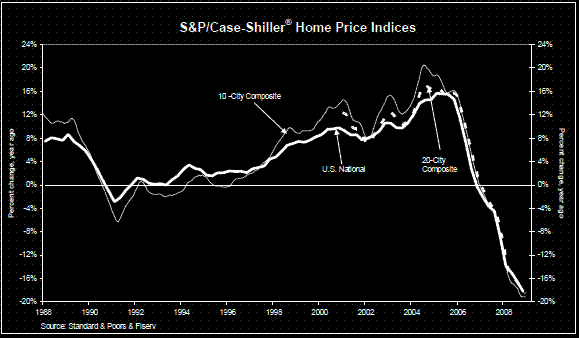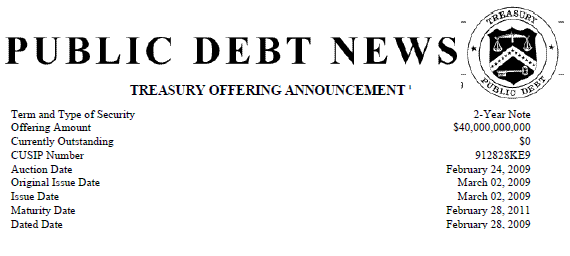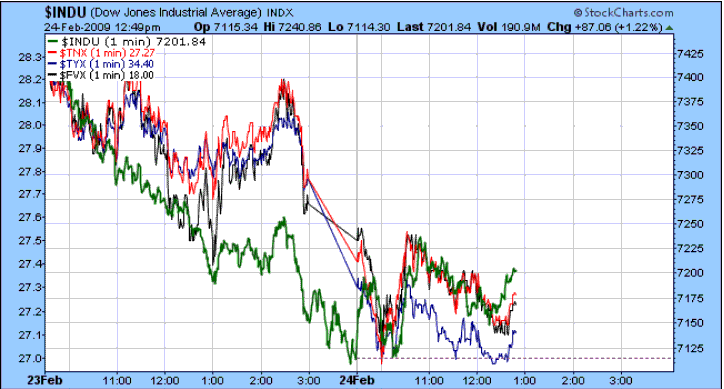The MBS stack is currently a mere silhouette in the vast shadow that has been cast over global financial markets. Investor fears of pending bank nationalizations (direct or indirect) and multiplying mysteries surrounding government supported recovery proposals now fully dictate the direction of market money flows.
Currently "up in coupon" outperforms...the MBS market grows impatient and risk takers are dipping their toes in the water. Prepayment risks are unknown...we need more details TIMMAAAY!!!
1230 marks...
FN30_________________________________
FN 4.5 -------->>>> +0-02 to 100-30 from 100-28
FN 5.0 -------->>>> +0-03 to 102-02 from 101-31
FN 5.5 -------->>>> +0-03 to 102-18 from 102-15
FN 6.0 -------->>>> +0-06 to 103-09 from 103-03
Yesterday MBS moved in a tight range while the bond market weighed the price deterioration of new US Treasury supply vs. the market's insatiable demand for the safety and liquidity of AAA guaranteed US issued fixed income securities. All in all Treasuries ended the day relatively flat while stock markets absorbed the brunt of the gloom and doom. Treasury yields will continue to be subject to equity market emotions and stock trader sentiment while the herd awaits new Recovery Plan details from the Obama Administration, until then speculation and rumor will continue to feed the fire that fuels the furnace powering equity markets. When the masses find reason to rally, flight to quality will unwind in the Treasury market and benchmark interest rates will rise. When markets seek safety from the seemingly never ending sorrow in stocks fixed income yields will benefit as investors flock to the assurance of a government guarantee.
Nationally, Home Price Declines Closed Out 2008 with Record Lows According to the S&P/Case-Shiller Home Prices Indices
New York, February 24, 2009 - Data through December 2008, released today by Standard & Poor's for its S&P/Case-Shiller Home Price Indices, the leading measure of U.S. home prices, show that the prices of existing single family homes across the United States continue to set record declines, a trend that prevailed throughout all of 2007 and 2008.
"The decline in the S&P/Case-Shiller U.S. National Home Price Index - which covers all nine U.S. census divisions - recorded an 18.2% decline in the 4th quarter of 2008 versus the 4th quarter of 2007, the largest in the series' 21-year history. The 10-City and 20-City Composites also set new records, with annual declines of 19.2% and 18.5%, respectively"

"The broad downturn in the residential real estate market continues," says David M. Blitzer, Chairman of the Index committee at Standard & Poor's. "There are very few, if any, pockets of turnaround that one can see in the data. Most of the nation appears to remain on a downward path, with all of the 20 metro areas reporting annual declines, and eight of those MSA's now with negative rates exceeding 20%."
As long as home prices continue to fall, the valuation of bank owned real estate related assets will remain unworkable and the economy will remain in the grip of a deflationary spiral. Which brings up another question. The TSY department is set to begin their STRESS TESTS tomorrow...how are they going to accurately determine STRESS if they dont know the values of bank assets? Again...the toxic assets remain the core problem.
Ben Bernanke is being questioned by politicians at the moment. Here is the text of his speech...CLICK TO READ
Here are some excerpts from his statement...
"The immediate trigger of the crisis was the end of housing booms in the United States and other countries and the associated problems in mortgage markets, notably the collapse of the U.S. subprime mortgage market. Recent data show that residential construction and sales continue to be very weak, house prices continue to fall, and foreclosure starts remain at very high levels."
"...most securitization markets remain shut, other than that for conforming mortgages, and some financial institutions remain under pressure."
"In light of ongoing concerns over the health of financial institutions, the Secretary of the Treasury recently announced a plan for further actions...
"First, a new capital assistance program will be established to ensure that banks have adequate buffers of high-quality capital, based on the results of comprehensive stress tests to be conducted by the financial regulators, including the Federal Reserve.
Second is a public-private investment fund in which private capital will be leveraged with public funds to purchase legacy assets from financial institutions.
Third, the Federal Reserve, using capital provided by the Treasury, plans to expand the size and scope of the TALF to include securities backed by commercial real estate loans and potentially other types of asset-backed securities as well.
Fourth, the plan includes a range of measures to help prevent unnecessary foreclosures."
"....a full recovery of the economy from the current recession is likely to take more than two or three years."
US Treasury 2 YR NOTE AUCTION BEGINS AT 1PM EST

Stocks and Bonds...






